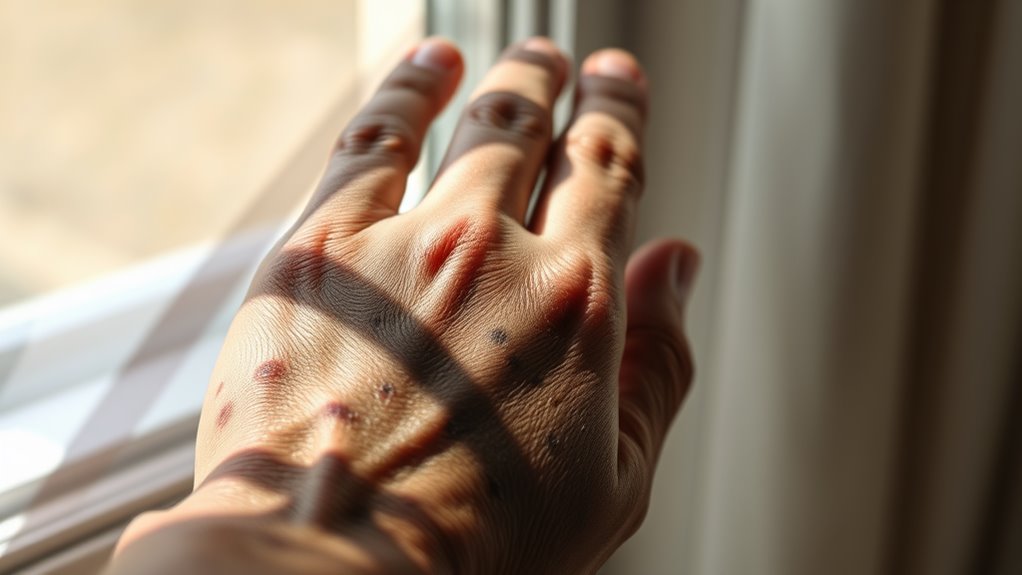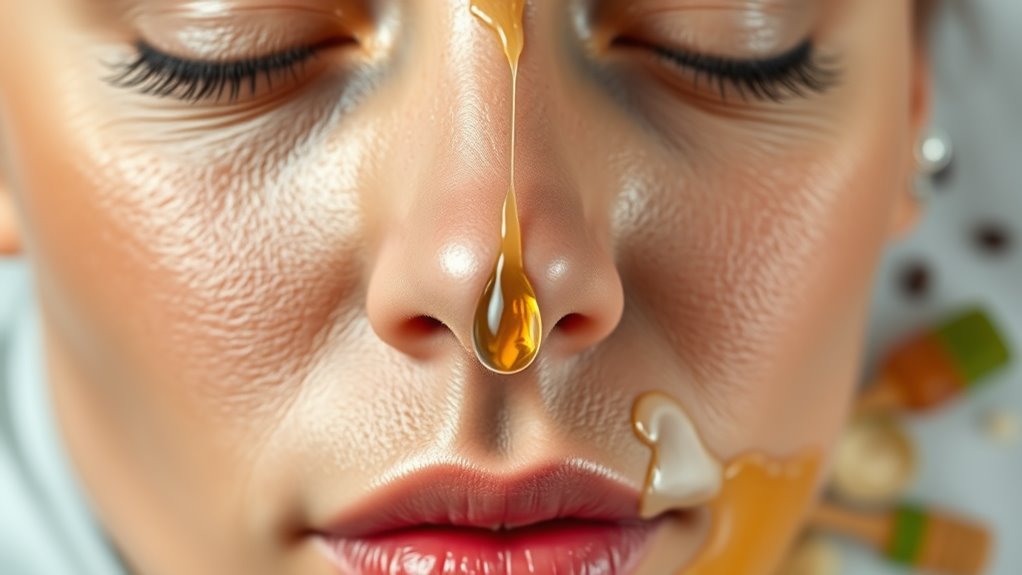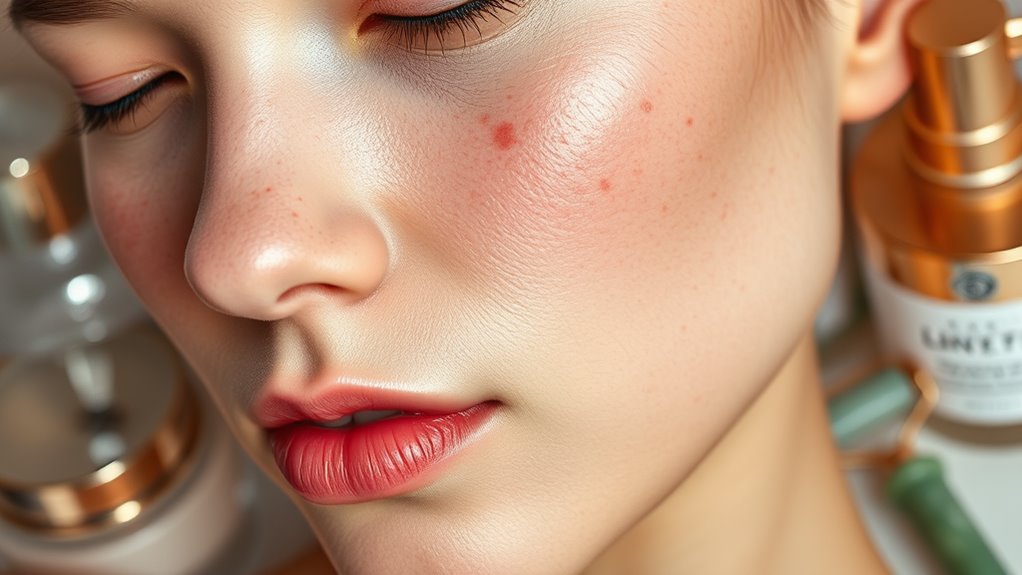Why You’re Seeing More Dark Spots With Age – and How to Stop Them
As you age, dark spots—often called age spots or sunspots—become more common due to increased melanin production from sun exposure, hormonal changes, and genetics. To prevent them, you should use a broad-spectrum sunscreen daily, wear protective clothing, and maintain a skincare routine rich in antioxidants. Treatment options like chemical peels and laser therapy can help reduce existing spots. Discovering the right strategies can keep your skin looking youthful and radiant.
Key Takeaways
- Increased melanin production from sun exposure and aging leads to the formation of dark spots on the skin.
- Hormonal changes, particularly during menopause, can cause skin to become thinner and more prone to dark spots.
- Genetics and existing skin type influence susceptibility to developing dark spots as you age.
- Daily use of broad-spectrum sunscreen and antioxidants can significantly prevent and reduce dark spot formation.
- Regular skincare routines and professional treatments like chemical peels or laser therapy can effectively target and diminish dark spots.
Understanding Dark Spots: What Are They?
Dark spots, often referred to as age spots or sunspots, are flat, brown, or black patches that appear on the skin as you age.
These dark spots with aging occur due to an increase in melanin production, the pigment responsible for skin color. As your skin undergoes changes, factors such as genetics and hormonal shifts can contribute to this excess melanin, leading to uneven pigmentation.
While primarily harmless, dark spots can affect your skin’s appearance and self-esteem. Understanding their formation is crucial for effective prevention and treatment. Sun exposure is one of the primary causes that accelerates the development of these spots.
You can adopt a proactive approach by utilizing topical treatments, maintaining a consistent skincare routine, and considering professional dermatological options to minimize their appearance and enhance your skin’s overall health.
The Role of Sun Exposure in Dark Spot Formation
Sun exposure plays a significant role in the formation of dark spots on the skin. When your skin is exposed to ultraviolet (UV) rays, it triggers the production of melanin as a protective response.
Over time, this increased melanin can lead to uneven pigmentation, resulting in dark spots or hyperpigmentation. Such spots are often exacerbated by cumulative sun exposure throughout your life, especially if you haven’t consistently protected your skin. Even brief, unprotected exposure can contribute to this process.
To minimize the risk of developing dark spots, you should incorporate broad-spectrum sunscreen into your daily routine, wear protective clothing, and seek shade during peak sunlight hours. Additionally, proper sun protection can significantly reduce the likelihood of developing these spots over time.
Hormonal Changes and Their Impact on Skin
As you age, hormonal fluctuations can significantly influence your skin’s appearance and health. Changes in estrogen and progesterone levels, particularly during menopause, can lead to decreased collagen production and altered pigmentation.
This reduction often results in a thinner skin barrier, making it more susceptible to environmental damage and dark spots. Additionally, androgens can increase oil production, potentially exacerbating skin issues. You might notice that skin healing slows down, allowing dark spots to linger longer.
To combat these effects, consider incorporating products rich in antioxidants and retinoids into your skincare routine, as they promote cell turnover and improve skin texture. Staying hydrated and maintaining a balanced diet can also support hormonal balance and overall skin vitality. Furthermore, understanding the common causes of dark spots can help you take proactive measures in your skincare regimen.
Genetics: Are You Predisposed to Dark Spots?
Your genetic makeup plays a crucial role in determining your likelihood of developing dark spots as you age.
If you have a family history of hyperpigmentation, you may be more prone to these skin changes, especially when combined with your specific skin type.
Additionally, variations in gene expression can influence how your skin responds to environmental factors, further impacting the appearance of dark spots. Understanding the causes of dark spots can help you take proactive measures to prevent their formation.
Family History Impact
While lifestyle factors play a significant role in skin health, genetics can also influence your likelihood of developing dark spots as you age. If your family has a history of hyperpigmentation, you might be predisposed to experiencing similar issues.
Research indicates that certain genes regulate melanin production, which can lead to uneven skin tone and dark spots. Environmental factors like sun exposure can exacerbate these genetic tendencies.
Understanding your family history empowers you to take proactive measures, such as regular skin checks and tailored skincare routines. By acknowledging the genetic component, you can better navigate your skincare choices, focusing on prevention and treatment strategies that align with your unique genetic profile.
Skin Type Considerations
Understanding your family history can shed light on your skin’s susceptibility to dark spots, but skin type also plays a pivotal role in this equation.
Individuals with lighter skin, particularly those with fair or sensitive complexions, are often more prone to sun damage, which can lead to increased pigmentation over time. Conversely, darker skin types may have a genetic advantage in producing more melanin, but they’re not immune to hyperpigmentation.
Factors such as oiliness, dryness, and sensitivity can influence how your skin reacts to environmental stressors and hormonal changes. Recognizing your specific skin type allows you to tailor your skincare routine, thereby minimizing the risk of developing dark spots and promoting a more even skin tone as you age.
Gene Expression Influence
As genetics play a crucial role in skin health, certain individuals may find themselves more predisposed to developing dark spots as they age. Variations in genes influence melanin production, skin thickness, and repair mechanisms.
If you have a family history of hyperpigmentation, your risk of experiencing these age-related changes increases. Additionally, gene expression can be affected by environmental factors, such as UV exposure, which may exacerbate the genetic predisposition.
Research indicates that specific gene variants can lead to an overproduction of melanin, resulting in uneven skin tone. Understanding your genetic background allows you to adopt targeted preventative measures, including tailored skincare routines and proactive sun protection.
Effective Prevention Strategies for Dark Spots
To effectively prevent dark spots, incorporating a consistent skincare routine is essential.
Start by using broad-spectrum sunscreen daily, as UV exposure accelerates melanin production. Choose a sunscreen with at least SPF 30, and reapply every two hours, especially if you’re outdoors.
Secondly, integrate antioxidants like vitamin C into your routine; they combat oxidative stress and enhance skin brightness.
Regular exfoliation, using alpha or beta hydroxy acids, helps remove dead skin cells, promoting cell turnover and reducing dark spot formation.
Additionally, consider incorporating products with niacinamide or licorice extract, known for their skin-brightening properties.
Lastly, stay hydrated and maintain a balanced diet rich in vitamins, as overall skin health plays a pivotal role in prevention. Furthermore, dark spots can stubbornly linger due to various factors, making ongoing care and attention crucial for effective treatment.
Treatment Options: How to Reduce Existing Dark Spots
Even with the best preventive measures, dark spots can still appear.
Fortunately, several effective treatment options exist to help you reduce their visibility. Here are some approaches you might consider:
-
Topical treatments: Look for products containing ingredients like hydroquinone, retinoids, or vitamin C to lighten dark spots.
-
Chemical peels: These treatments exfoliate the skin, removing the top layer and helping to fade pigmentation.
-
Laser therapy: Targeted laser treatments can break down melanin deposits, offering significant improvement.
-
Microdermabrasion: This procedure gently exfoliates the skin, promoting cell turnover and reducing the appearance of dark spots.
Consult a dermatologist to determine the best course of action tailored to your skin type and concerns.
Maintaining Healthy Skin as You Age
Maintaining healthy skin as you age requires a proactive approach to skincare and lifestyle choices. Start by using broad-spectrum sunscreen daily to protect against UV damage, which accelerates aging and dark spot formation.
Incorporate antioxidants, such as vitamin C, into your regimen to combat free radicals and promote collagen production. Hydration is key; ensure you drink plenty of water and use moisturizers containing hyaluronic acid to maintain skin elasticity.
Regular exfoliation helps remove dead skin cells, promoting a brighter complexion. Additionally, consider incorporating retinoids, which can enhance cell turnover and reduce the appearance of fine lines.
A balanced diet rich in vitamins, minerals, and healthy fats will support your skin’s health from the inside out. Prioritize sleep and stress management for optimal results.




